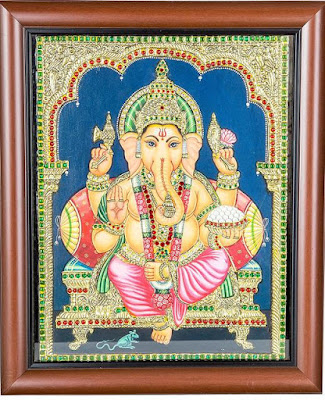Tanjore expressions or the Tanjore paintings are the enthusiastic craft of India in the ancient circumstances. These painting are extremely importance and said to contain bring home positive vitality. Yet, now just a bunch of individuals think about these painting and subsequently it is getting to be terminated like our lions and tigers.
It is said that the most seasoned and first know Traditional Tanjore Paintings is around 40,000 years of age and it is made in the Thanjavur, a city of Tamil Nadu, India. The painting in that circumstances were plan with unique gold foils and valuable stones and to make them brighter the craftsmen utilize oil paints and subsequently the painting acquires long life. This is the reason we discover the Tanjore painting the same as previously.
There is an unmistakable contrast between a typical painting and a Tanjore painting. These Tanjore paintings are more one of a kind and real then some other painting and said to convey an exceptional sort of vitality to home. The craftsmen utilize different valuable and semi valuable stones and jewels to fill the decorations and attire of the beauty full dolls that are for the most part Shiva, Vishnu, Lakshmi, Sarastwati, Parvathi, Krishna, Radha, Ganesha and Balaji Tanjore painting.
Current circumstances influenced the Tanjore paintings like each other old things. With a specific end goal to make due in the advanced time the craftsmen rolled out couple of improvements in the Tanjore painting. Despite the fact that they deal with the principle part of the Tanjore painting to stay same yet the material utilized as a part of it now somewhat extraordinary.
It is said that the most seasoned and first know Traditional Tanjore Paintings is around 40,000 years of age and it is made in the Thanjavur, a city of Tamil Nadu, India. The painting in that circumstances were plan with unique gold foils and valuable stones and to make them brighter the craftsmen utilize oil paints and subsequently the painting acquires long life. This is the reason we discover the Tanjore painting the same as previously.
There are two sorts of configuration essentially utilized as a part of Traditional Tanjore Paintings and they are Chettinad and Mysore plans.
1. Chettinad Tanjore painting: As the first and most established painting this kind of painting likewise started in the city of Tamil Nadu, Thanjavur. The forte of this sort of painting are thick lines, strong hues, proper shapes planned adjusting in each line of the painting. There is no flabby in this painting and has a utilization of proper shading. The life of these Chettinad Tanjore paintings is found around 1600 A.D.
2. Mysore Tanjore painting: These sorts of Tanjore painting depict the life and history of the time around second century B.C. to seventh century A.D. This sort of painting is started in a city of Karnataka named Mysore which is particularly configuration to move the sentiment of commitment among the general population. The fragile lines, unpredictable brush strokes, utilization of splendid vegetable hues, agile depiction of figures which are for the most part Hindu fanciful Gods and Goddesses are the particularly of these sorts of paintings.
2. Mysore Tanjore painting: These sorts of Tanjore painting depict the life and history of the time around second century B.C. to seventh century A.D. This sort of painting is started in a city of Karnataka named Mysore which is particularly configuration to move the sentiment of commitment among the general population. The fragile lines, unpredictable brush strokes, utilization of splendid vegetable hues, agile depiction of figures which are for the most part Hindu fanciful Gods and Goddesses are the particularly of these sorts of paintings.
There is an unmistakable contrast between a typical painting and a Tanjore painting. These Tanjore paintings are more one of a kind and real then some other painting and said to convey an exceptional sort of vitality to home. The craftsmen utilize different valuable and semi valuable stones and jewels to fill the decorations and attire of the beauty full dolls that are for the most part Shiva, Vishnu, Lakshmi, Sarastwati, Parvathi, Krishna, Radha, Ganesha and Balaji Tanjore painting.
Current circumstances influenced the Tanjore paintings like each other old things. With a specific end goal to make due in the advanced time the craftsmen rolled out couple of improvements in the Tanjore painting. Despite the fact that they deal with the principle part of the Tanjore painting to stay same yet the material utilized as a part of it now somewhat extraordinary.






